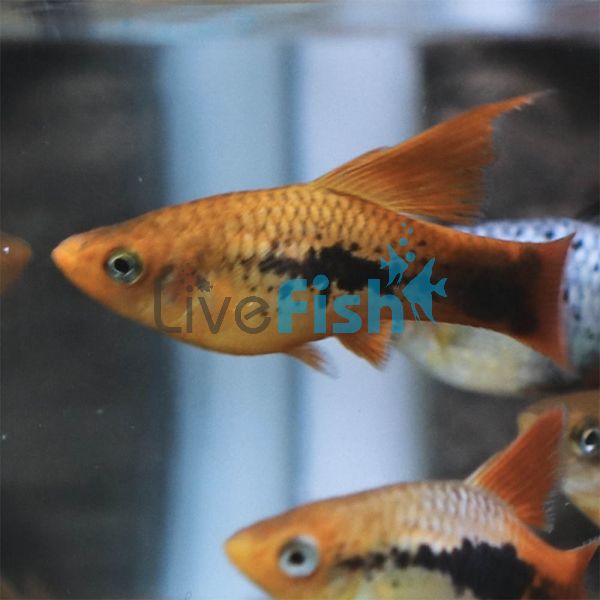Hi-Fin Platy 4cm
The greatest thing with fish like Platies is that there always seems to be a new colour variation coming out. This is simply because they are so easy to breed and aquarists can easily experiment with colour genetics and produce new and unique colour strains never seen before. It’s almost exciting to see what new colour strain is available and one of the oldest, most classic, and still popular strains is the hi-fin platy.
- Buy 5 for $8.93 each and save 10%
- Buy 10 for $7.94 each and save 20%
Hi-Fin Platy
The greatest thing with fish like Platies is that there always seems to be a new colour variation coming out. This is simply because they are so easy to breed and aquarists can easily experiment with colour genetics and produce new and unique colour strains never seen before. It’s almost exciting to see what new colour strain is available and one of the oldest, most classic, and still popular strains is the hi-fin platy.
The beauty of hi-fin Platies is that they come in a range of different colours but they all carry the high dorsal fin which is a selectively bred trait. This is unique as most aquarium fish tend to carry the long fin gene which accentuates all the fins whereas for hi-fin platy it is just the dorsal fin. The most common colour seen in these fish is the variates strain which is quite dominant in the yellow, red, and orange hues however these do come in a massive assortment of colours. Blues, whites, Dalmation, and solid colours are not uncommon at all. Unlike other livebearers such as guppies where the males tend to be far more colourful than females, Platies share their fantastic colour in both males and
females. Because of this, it makes them extremely desirable in a display-style aquarium.
Platies are great because they only get to around to around 6-7 cm from head to tail. They are also super peaceful fish meaning they can be kept with other aquarium fish but also in large shoals of other coloured hi-fin platies making a phenomenal rainbow platy aquarium. Breeding them is also a breeze, there isn’t much interference required to get these fish to breed because it’s bound to happen. Males can be distinguished by their gonoponium which is like a pointed ventral fin. The wild habitat of the natural platy is widespread from Central America to Mexico.
Tank Recommendations for your Hi-Fin Platy
Being a very small and easy to care for fish the hi-fin platy can be kept in nano aquariums with the minimum being a 60 litre system. Platies would do perfectly fine in either a tall or long tank which makes them super versatile. A sand or gravel substrate would be fine for these fish as well as a lot of plant growth which not only makes them contrast well but also makes for handy locations where fry can grow out. Platies however are considered to be ‘hard water fish meaning they prefer the water to have an elevated PH and are not like a tetra. This higher PH of 7 - 8 can be achieved with a PH buffer or African cichlid lake conditioning salts.
Suitable Tank Buddies
The hi-fin platy is a very peaceful aquarium fish. They are great with a wide range of nano aquarium fish however because of their bright and flashy fins, certain fin-nipping species would be avoided. The other factor is that platies are fish that need higher PH so keeping them with South American tetras may not be very suitable as these prefer lower PH.
Usually Compatible
Pseudomogil species such as fork-tail rainbows, blue eyes, ricefish, and nano aquarium fish can tolerate hard water conditions.
Sometimes Compatible
Medium-growing or possibly fin-nipping species. Bettas should also be avoided because of their similar flashy nature to platies which could lead to aggression from the bettas end.
Rarely Compatible
Large and aggressive species that would prey on the guppies such as
oscars, or jaguar cichlids.
Feeding your Hi-Fin Platy
The Hi-Fin platy is very easy to feed once it is settled into the aquarium. The ideal diet would be good quality floating food, supplemented with frozen bloodworms or black worms or even live foods like baby brine shrimp or micro worms. Feeding any foods with natural colour enhancers would also be great as this will enhance the oranges.
| Scientific Name | Xiphophorus Maculatus |
|---|---|
| Care Level | Easy |
| Common Names | Hi-Fin Platy |
| Diet | Omnivore |
| Fish Family | Poeciliidae |
| Lifespan (years) | 4 |
| Max. Length (cm) | 6 |
| Min. Tank Volume (l) | 60 |
| Origin | North America |
| Reef Safe | Yes |
| Sociability | Peaceful |
| Venomous | No |
| Water Conditions | 24-26° C, pH 7.0-8.0 |




